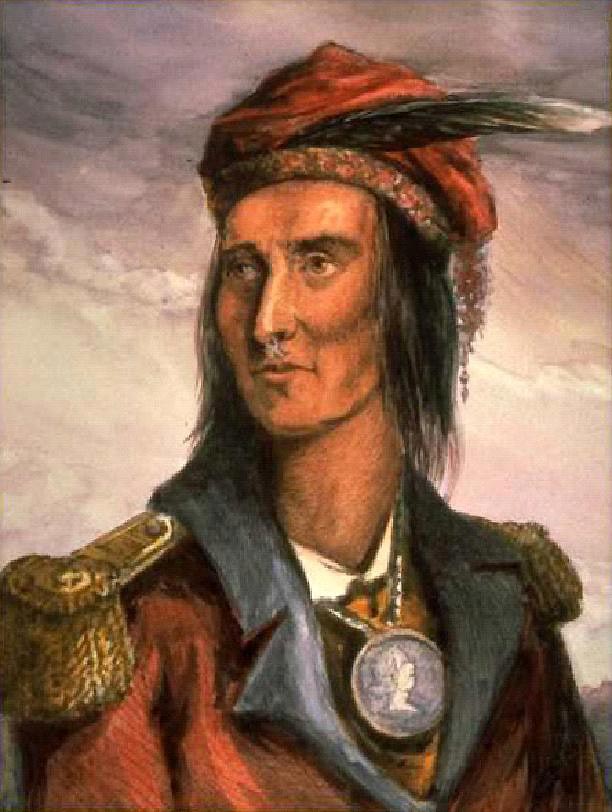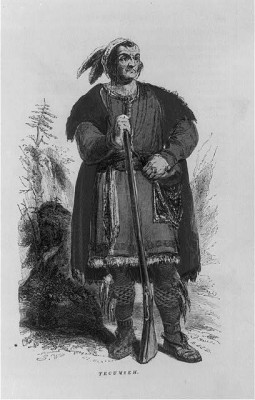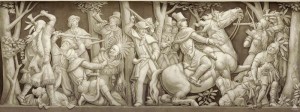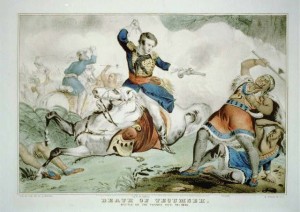| Tecumseh | |
|---|---|
 |
|
| Native American Hero | |
| Born | Mar., 1768 On the Scioto River, near Chillicothe, Ohio |
| Died | Oct. 5, 1813 (at age 45) Moravian of the Thames (in modern Chatham-Kent, Ontario) |
| Nationality | Shawnee |
Tecumseh (1768-1813) was an intelligent and widely respected ruler of the native Shawnee Indians who inhabited regions of America in the early 1800s. Available historical records state that he was probably born in March of 1768 near present day Springfield region in Ohio.
The name Tecumseh, in native Shawnee, loosely means “the shooting star” or “panther crouching in wait.” These two meanings to some extent signify his character as he was an aggressive, quick, and sharp leader.
Tecumseh’s father was called Puckshinwa, a war chief of the Shawnee people. Not many details are available about his mother, Methotaske, although it is widely believed that she had some Creek blood.
Tecumseh ruled shortly after the Revolutionary War, when American settlers were beginning to expand westward. He is listed as one of the shrewdest leaders who were opposed to the idea of foreigners inhabiting the native community’s land. Historical facts state that he led a group called Tecumseh’s confederancy in a bid to resist any form of invasion in their land.
Tecumseh was particularly interested in protecting the land between the Ohio and Mississippi valleys and thus he marshaled his military might to resist any attempts to take it. Although he was not successful in his attempts, his principled rule made him a respected figure in various cultures.
The Early Days
Tecumseh is believed to have been born on the shores of the Scioto River in the present day city of Chillicothe. When he was a young boy, his father was killed by white soldiers who had attacked his native land in violation of a recent treaty. During the infamous battle, commonly referred to as the Battle of Point Pleasant which took place during the reign of Lord Dunmore, it is claimed that he was so bitter at the loss of his father that he swore to become a warrior in order to secure his people’s territory.
When he was 15, after the American Revolt had come to an end, Tecumseh joined the Shawnee army and vowed to stop the white invasion of their territory by attacking settlers’ boats travelling down the Ohio River. His battle strategy is said to have been so effective that river traffic virtually came to a stop.
His Family
Historians believe that by the time Tecumseh’s parents met, their tribe was living somewhere around present day Alabama alongside the Creek tribe as they had been chased from their native land by the Iroquois during the 17th century Beaver Wars.
Around 1760, Puckshinwa is said to have relocated his family northwards where they founded a settlement. Not long after settling in this new region, Puckshinwa took part in the French-Indian War.
Warfare
 Tecumseh grew up in Ohio Country during the American Revolutionary War and the Northwest Indian War, where he was continuously exposed to warfare. With invaders continuing to encroach on Indian territory, the Shawnee were pushed farther and farther northwest. In the early 1800’s they settled in regions around present-day Indiana.
Tecumseh grew up in Ohio Country during the American Revolutionary War and the Northwest Indian War, where he was continuously exposed to warfare. With invaders continuing to encroach on Indian territory, the Shawnee were pushed farther and farther northwest. In the early 1800’s they settled in regions around present-day Indiana.
It is at this point in time that Tecumseh saw the need to establish an independent state for his people. He recruited additional tribes in preparation for a fight to secure the area from external invasion.
In early 1812, with the support of British men from Canada, he fought and overcame the American forces to capture Fort Detroit. However, he was attacked by the Americans the following year in a battle known as the Battle of the Thames, where he was shot and killed.
Following his death, the various tribes disbanded, the Canadian-British deserted his people, and the dream of an independent Indian state was abandoned. The American settlers took possession of all the territory driving the local communities into reservations or farther west.
The Pan Indian Dream
Frustrated by Indian communities that sold land to white settlers, Tecumseh proposed that the communities come together. He wanted to establish a union strong enough to stop the selling of land to the invaders.
His ideas brought him into conflict with the American government. The British who settled in Canada gave their support to Tecumseh forming a coalition that brought together all Indian tribesmen and British forces in an effort to thwart American expansionism. His decision to commit his life fighting for the liberty of the Indian tribes raised his standing among his peers.
Growing Tension
 By year 1810, Tecumseh had managed to marshal up enough financial and physical power to attack the Americans. Soon, he was brought in direct confrontation with the ruler of the Indiana territory, Henry Harrison. At that point in time, Indiana covered the present day Illinois, Indiana, Michigan, and Wisconsin.
By year 1810, Tecumseh had managed to marshal up enough financial and physical power to attack the Americans. Soon, he was brought in direct confrontation with the ruler of the Indiana territory, Henry Harrison. At that point in time, Indiana covered the present day Illinois, Indiana, Michigan, and Wisconsin.
In late 1810, Tecumseh met Harrison at what was dubbed the Council of Vincennes. During this meeting, Tecumseh delivered a very harsh speech directed at Harrison demanding that Indian Territory be returned. However, what was meant to be a diplomatic meeting turned into a rivalry. The Americans felt challenged to go to war. Tecumseh on his part had made a point and he seemed ready to defend his opinion by any means necessary. These events led to a series of battles pitting Tecumseh’s men together with British forces against the American government.
Battle of Tippecanoe
One of the most memorable battles in which Tecumseh led his men was the Battle of Tippecanoe. Then, that region of America was under the leadership of Governor Harrison. Available historical records claim that after receiving news that Tecumseh was preparing for war, the governor quickly mobilized his militia to counter any attacks from the Shawnee. He marched his troops from Vincennes to Tippecanoe and then to Prophetstown. On November 7, 1811, Harrison’s men launched an attack on Prophetstown forcing the Indians to withdraw from their camp after the battle to safer grounds. The American troops burned down the town and returned to Vincennes.
This battle was a blow to Tecumseh’s efforts and resulted in his loss of confidence in his brother who was in charge as the chief prophet in the town. However, he began secretly rebuilding an alliance in an attempt to launch retaliatory attacks.
The Siege of Detroit
Soon after the battle of Tippecanoe, the Americans went to war with the British.
In mid 1782, Tecumseh had managed to rally more support towards his quest for victory. He had even received direct support of the British army under the guidance of Sir Isaac Brock.
With a new strategy and with more sophisticated equipment and logistical support, Tecumseh managed to raid Detroit and reclaim it from the Americans. This victory elevated his relationship with the British.
It is claimed that the next British commander who took over honored Tecumseh for his instrumental role in the Battle of Detroit by giving him a sash and offering him a senior position in the British army. However, Tecumseh refused the position and gave the sash away.
The British victory at Detroit did not last long as the American forces captured a strategic British military post on Lake Erie and cut the supply lines. After this, the British were forced to retreat further northwards, which they did after burning the city of Detroit into ashes.
The Battle of the Thames
Tecumseh’s relationship with the British began to decline as he did not agree with their new commander, Henry Procter, over warring tactics. Procter did not support war between his territory and America. He preferred withdrawing into the North over fighting. Contrastingly, Tecumseh was eager to launch a decisive battle against the Americans to end their military might.
Meanwhile the American forces were busy eating into the northern territory and Tecumseh was hard put to stop this worrying trend. He made a deal with Procter to combine their armies at Ontario to stop the American insurgents from taking over more of the Shawnee’s land. However, Procter did not honor the deal and left Tecumseh to fight alone despite numerous pleas for support.
In October of 1813, the American forces attacked regions near Moraviantown and achieved victory over the Native American and British forces. In this encounter, dubbed the Battle of Thames, Tecumseh was killed. As a result, most of the tribes that had been under his command surrendered to Harrison.
His Death
 Historians differ about the circumstances surrounding Tecumseh’s death. Some claim that he was killed by Col. Richard Johnson during a cavalry attack. Others, like Peter D. Clarke, claimed that he was shot by one of Harrison’s army men though he did not state who in particular. He further went on to claim that his body was found by his friend where he had laid down to die, untouched.
Historians differ about the circumstances surrounding Tecumseh’s death. Some claim that he was killed by Col. Richard Johnson during a cavalry attack. Others, like Peter D. Clarke, claimed that he was shot by one of Harrison’s army men though he did not state who in particular. He further went on to claim that his body was found by his friend where he had laid down to die, untouched.
Tecumseh’s Legacy
 Although he was unsuccessful in creating a free state for his native American tribesmen, Tecumseh’s courage and unending determination make him an admirable figure to many Americans and historians. The city of Ontario is home to one of his most notable plaques which was erected in his honor and in commemoration of his long-lived friendship with the British. It resides in Tecumseh Park, located along William Street.
Although he was unsuccessful in creating a free state for his native American tribesmen, Tecumseh’s courage and unending determination make him an admirable figure to many Americans and historians. The city of Ontario is home to one of his most notable plaques which was erected in his honor and in commemoration of his long-lived friendship with the British. It resides in Tecumseh Park, located along William Street.
The U.S. Naval Academy in Maryland has Tecumseh Court which features a bust of Tecumseh. The bust is often used to mark special days. In addition, the American Navy commemorated the important role played by Tecumseh in history by naming four of their battle ships USS TECUMSEH.
Tecumseh is honored in Canada for his immense contribution to its repulsion of an American attack in 1812. The tributes erected in his honor include being ranked 37th in the list of the Greatest Canadians, artistic paintings—some of them putting him in a British uniform—and a portrait which hangs in the Canadian Military Institute.
There are also a number of towns which have been named in his honor in the province of Ontario, states of Michigan, Kansas, Oklahoma, Missouri, and Nebraska.
Tecumseh’s role in America’s and Canada’s histories is no doubt an important one. Not only do his actions mark him as a hero among his friends and foes but his sense of determination remains crystal clear in the minds of many scholars to date.